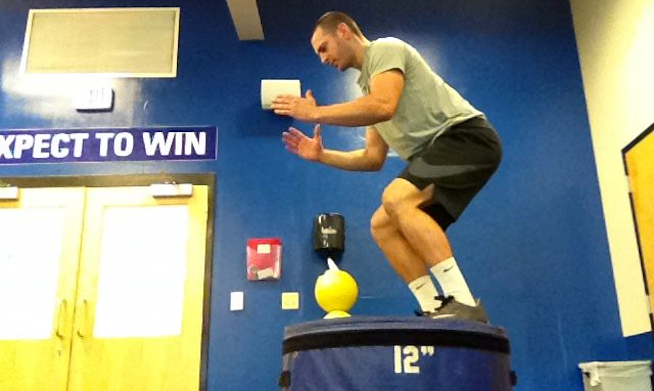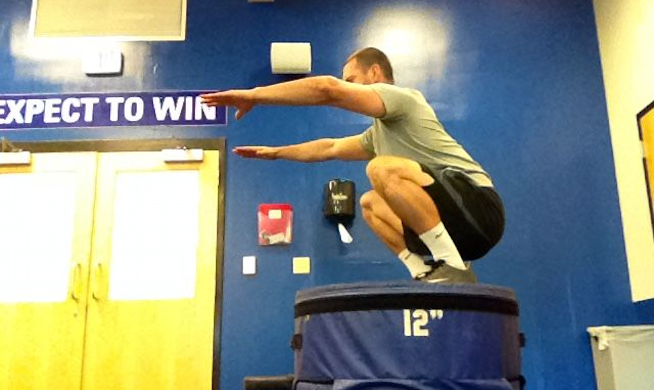3 Common Box Jump Mistakes That Might Be Holding You Back
The Box Jump is a popular exercise for athletes of all ages.
In recent years, a number of viral videos have shown athletes jumping onto absurdly high boxes, only increasing the move’s popularity.
Unfortunately, it is those same social media videos that often feature crummy technique. A proper Box Jump has become a rare sight nowadays, and improper form or technique greatly reduces the exercise’s effectiveness. With that in mind, here are three common Box Jump mistakes that could be holding you back.
Mistake 1: Jumping on a box that’s too high
This mistake is directly connected with what young athletes are seeing on social media. A high-level athlete jumps onto a box that is 6-feet tall and lands in a deep squat position. It is undoubtedly an impressive feat of athleticism, but does that athlete really have a 6-foot vertical? The obvious answer is no.
The athlete jumped their normal vertical, maybe 30-40 inches depending on the individual, and then drove their knees up into their chest so their feet could clear the edge of the box. This places a ton of stress on their joints and connective tissue, as the position doesn’t allow the muscles to absorb the landing impact as intended. This error has become so prominent that I have even heard coaches teach the knee drive in Box Jumps. The athlete could have used a 30- to 40-inch box and performed the exact same amount of work without adding the unnecessary risk needed to clear those extra 30-plus inches. The Box Jump is primarily designed to develop landing mechanics, but that jump did nothing to help with proper landing technique. If anything, it engrained a poor deep squat movement pattern into your landings.
Here’s what a proper Box Jump landing looks like:

And here’s what an improper landing looks like:

Notice how much higher my hips are in the first photo. The box is the same height, but I had to jump probably 18 inches higher to land with only a slight bend at the hips and knees as opposed to landing in a deep squat position. Also notice in the first photo that I have a ball resting on a cone toward the back edge of the box. This reinforces the purpose of the exercise, which is to work on landing mechanics. By landing softly with my knees out, I’m practicing good landing mechanics and the ball should stay on the cone. But if the ball regularly falls off the cone during your landings, your landings are too noisy and you’re likely not practicing good mechanics. if you use this trick, just make sure you’re using a box that’s large enough to accommodate the cone and ball but that also leaves you plenty of room to land safely.
Never let your ego get in the way of your training goals. Use a lower box, practice good mechanics, and get more out of the Box Jump. The result will be increased athleticism and a decreased risk of injury.
Mistake 2: Jumping backwards off the Box
The Box Jump is primarily designed to develop landing mechanics. Because the athlete is landing on a box above them, the force of the landing is reduced. This beneficial component of the Box Jump is totally wasted when you decide to jump backwards off the box between each rep. This doubles the number of landings you endure during training, and the backwards landings are much more forceful (and therefore, much more potentially damaging) than the forward landings. No one at any training age should jump backwards off of a box. Not only can you not see where you’re landing, but your body is not designed to absorb force coming backwards. Plyometrics, no matter how intense, should always be performed moving forward or laterally, never backwards. Jumping backwards off the box puts a ton of stress on your Achilles tendon and is an easy way to get hurt. Ideally, you can place a smaller box on the other side of the main box so you can easily step down onto it and keep the stress to a minimum.
Mistake 3: Doing way too many box jumps
The Box Jump is a great exercise to introduce any plyometric program. However, if your plyometric program consists solely of Box Jumps, you’ve got a pretty crummy program. Box Jumps teach athletes to be explosive and how to land properly, but they do not increase sprint speed nor jumping ability like a true plyometric program. After a couple weeks of properly executed Box Jumps, athletes should progress to more complex plyometric exercises. Below you can see a basic bilateral plyometric progression (video examples):
- Level 1: Box jump
- Level 2: Hurdle Jump (Stick the landing, knees out)
- Level 3: Hurdle Jump (with Bounce)
- Level 4: Hurdle Jump (Continuous)
- Level 5: Depth Jumps
In summary, get a proper-sized box and focus on your landing mechanics with every single rep. If you have to pull your knees up to your chest so your feet clear the edge of the box, the box is way too high and you’re defeating the purpose of the exercise. Additionally, do not jump backwards off of the box. Finally, when you have mastered the landing mechanics and can safely land on the box, move to something more complex and effective. There are countless challenging and fun plyometric exercises out there, none of which should include jumping onto an ultra-high box with poor technique. Use the box jump for its purpose, and then move on to something else.
Photo Credit: Antonio_Diaz/iStock
READ MORE:
RECOMMENDED FOR YOU
MOST POPULAR
3 Common Box Jump Mistakes That Might Be Holding You Back
The Box Jump is a popular exercise for athletes of all ages.
In recent years, a number of viral videos have shown athletes jumping onto absurdly high boxes, only increasing the move’s popularity.
Unfortunately, it is those same social media videos that often feature crummy technique. A proper Box Jump has become a rare sight nowadays, and improper form or technique greatly reduces the exercise’s effectiveness. With that in mind, here are three common Box Jump mistakes that could be holding you back.
Mistake 1: Jumping on a box that’s too high
This mistake is directly connected with what young athletes are seeing on social media. A high-level athlete jumps onto a box that is 6-feet tall and lands in a deep squat position. It is undoubtedly an impressive feat of athleticism, but does that athlete really have a 6-foot vertical? The obvious answer is no.
The athlete jumped their normal vertical, maybe 30-40 inches depending on the individual, and then drove their knees up into their chest so their feet could clear the edge of the box. This places a ton of stress on their joints and connective tissue, as the position doesn’t allow the muscles to absorb the landing impact as intended. This error has become so prominent that I have even heard coaches teach the knee drive in Box Jumps. The athlete could have used a 30- to 40-inch box and performed the exact same amount of work without adding the unnecessary risk needed to clear those extra 30-plus inches. The Box Jump is primarily designed to develop landing mechanics, but that jump did nothing to help with proper landing technique. If anything, it engrained a poor deep squat movement pattern into your landings.
Here’s what a proper Box Jump landing looks like:

And here’s what an improper landing looks like:

Notice how much higher my hips are in the first photo. The box is the same height, but I had to jump probably 18 inches higher to land with only a slight bend at the hips and knees as opposed to landing in a deep squat position. Also notice in the first photo that I have a ball resting on a cone toward the back edge of the box. This reinforces the purpose of the exercise, which is to work on landing mechanics. By landing softly with my knees out, I’m practicing good landing mechanics and the ball should stay on the cone. But if the ball regularly falls off the cone during your landings, your landings are too noisy and you’re likely not practicing good mechanics. if you use this trick, just make sure you’re using a box that’s large enough to accommodate the cone and ball but that also leaves you plenty of room to land safely.
Never let your ego get in the way of your training goals. Use a lower box, practice good mechanics, and get more out of the Box Jump. The result will be increased athleticism and a decreased risk of injury.
Mistake 2: Jumping backwards off the Box
The Box Jump is primarily designed to develop landing mechanics. Because the athlete is landing on a box above them, the force of the landing is reduced. This beneficial component of the Box Jump is totally wasted when you decide to jump backwards off the box between each rep. This doubles the number of landings you endure during training, and the backwards landings are much more forceful (and therefore, much more potentially damaging) than the forward landings. No one at any training age should jump backwards off of a box. Not only can you not see where you’re landing, but your body is not designed to absorb force coming backwards. Plyometrics, no matter how intense, should always be performed moving forward or laterally, never backwards. Jumping backwards off the box puts a ton of stress on your Achilles tendon and is an easy way to get hurt. Ideally, you can place a smaller box on the other side of the main box so you can easily step down onto it and keep the stress to a minimum.
Mistake 3: Doing way too many box jumps
The Box Jump is a great exercise to introduce any plyometric program. However, if your plyometric program consists solely of Box Jumps, you’ve got a pretty crummy program. Box Jumps teach athletes to be explosive and how to land properly, but they do not increase sprint speed nor jumping ability like a true plyometric program. After a couple weeks of properly executed Box Jumps, athletes should progress to more complex plyometric exercises. Below you can see a basic bilateral plyometric progression (video examples):
- Level 1: Box jump
- Level 2: Hurdle Jump (Stick the landing, knees out)
- Level 3: Hurdle Jump (with Bounce)
- Level 4: Hurdle Jump (Continuous)
- Level 5: Depth Jumps
In summary, get a proper-sized box and focus on your landing mechanics with every single rep. If you have to pull your knees up to your chest so your feet clear the edge of the box, the box is way too high and you’re defeating the purpose of the exercise. Additionally, do not jump backwards off of the box. Finally, when you have mastered the landing mechanics and can safely land on the box, move to something more complex and effective. There are countless challenging and fun plyometric exercises out there, none of which should include jumping onto an ultra-high box with poor technique. Use the box jump for its purpose, and then move on to something else.
Photo Credit: Antonio_Diaz/iStock
READ MORE:










